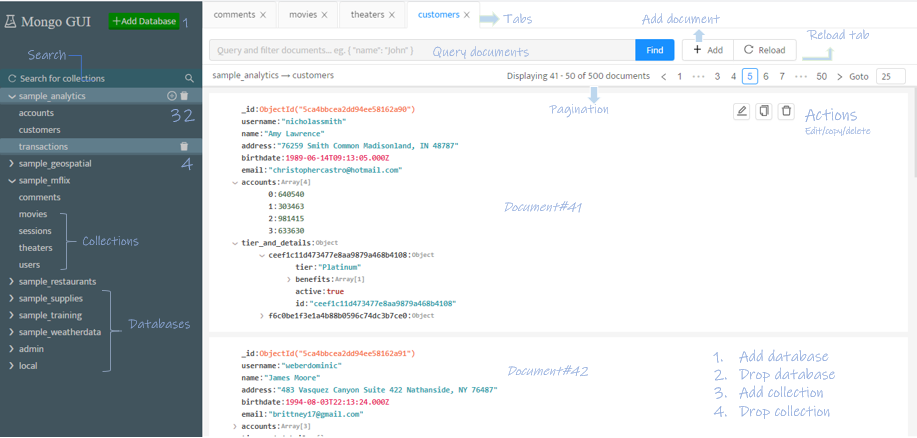
Security News
Oracle Drags Its Feet in the JavaScript Trademark Dispute
Oracle seeks to dismiss fraud claims in the JavaScript trademark dispute, delaying the case and avoiding questions about its right to the name.
A web-based MongoDB graphical user interface.
Read-only demo: http://20.106.238.56:4321/
The following are the different ways to install mongo-gui.
npm install -g mongo-guimongo-gui to run the applicationgit clone https://github.com/arunbandari/mongo-gui or download the zip file from here.cd mongo-guinpm installnpm start or node server.js commandNote: Node.js must be installed on your machine to run this application
Docker compose
version: '3'
services:
mongo-gui:
container_name: "mongo-gui"
image: ugleiton/mongo-gui
restart: always
ports:
- "4321:4321"
environment:
- MONGO_URL=mongodb://localhost:27017
The commands mongo-gui and npm start or node server.js start the application with the following configuaration:
URL (-u): mongodb://localhost:27017
PORT (-p): 4321
and the application will be accesible at http://localhost:4321
To connect to any other mongodb instance, pass mongo connection string as an argument, eg:
Installed via npm: mongo-gui -u mongodb+srv://<username>:<password>@host/<dbnames>?retryWrites=true&w=majority'
Installed via github: (npm start --/node server.js) -u mongodb+srv://<username>:<password>@host/<dbnames>?retryWrites=true&w=majority'
Available options:
When you want to use the interface on a remote server, you need to protect your data. Mongo-gui provides you with a simple authentication facility for this. This is completely optional, if you don't want authorization you don't use it. To use authorization, follow these steps:
.env file in the main directory.USERNAME=<your_username> variable for your username and PASSWORD="<your_password>" variable for your password.That's it. If you are working on your own computer, or if you do not need security, you can turn off the variables you have defined in the .env file by putting a comment before them, e.g.
#USERNAME=<your_username>Or you can delete your .env file.
So mongo-gui will now continue to run without asking for authorization. Don't forget to restart your server after these actions!
To enable the OpenAI-powered prompt querying in Mongo GUI, you'll need to obtain an API key from OpenAI and add it to your project. Here's a step-by-step guide:
Obtain an OpenAI API Key:
Add the API Key to Your Project:
.env file (or create one if it doesn't exist)..env file:
OPENAI_API_KEY=YOUR_API_KEY_HERE
YOUR_API_KEY_HERE with the API key you obtained from OpenAI.Save the .env file and restart Mongo GUI if it's currently running. With this, the AI-powered prompt querying should be activated!
🔐 Security Note: Remember to keep your .env file confidential. Never push it to public repositories or share it. It contains sensitive information.
This setup guide should provide your users with all they need to integrate the OpenAI prompt query into the tool. Adjust as needed to fit your specific application and user needs.

FAQs
A web-based MongoDB graphical user interface
The npm package mongo-gui receives a total of 136 weekly downloads. As such, mongo-gui popularity was classified as not popular.
We found that mongo-gui demonstrated a healthy version release cadence and project activity because the last version was released less than a year ago. It has 2 open source maintainers collaborating on the project.
Did you know?

Socket for GitHub automatically highlights issues in each pull request and monitors the health of all your open source dependencies. Discover the contents of your packages and block harmful activity before you install or update your dependencies.

Security News
Oracle seeks to dismiss fraud claims in the JavaScript trademark dispute, delaying the case and avoiding questions about its right to the name.

Security News
The Linux Foundation is warning open source developers that compliance with global sanctions is mandatory, highlighting legal risks and restrictions on contributions.

Security News
Maven Central now validates Sigstore signatures, making it easier for developers to verify the provenance of Java packages.